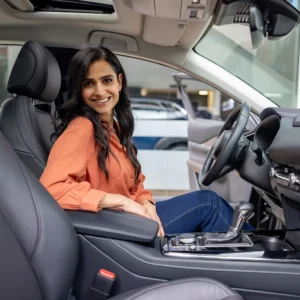ADAS feature education—that is, driver understanding of a vehicle’s automatic driver assistance systems—remains an ongoing pain point for many OEMs. Manufacturers pour untold research and development dollars into features, only to sit unused due to driver ignorance or disregard.
But what if an always-there, always-ready, always-informed hands-free assistant could pitch in with critical guidance? What if drivers were better informed about all the features of their vehicle—including ADAS feature education—and could decide when and how to use them based on need instead of strictly avoiding them out of technophobia?
Tweddle Group Business Development Director Laura McGowan has supported her company’s AVA (Advanced Vehicle Assistant) project since its unveiling at CES 2025.
In Part One of our interview, Laura outlined the project’s inception and explained how CAN bus integration, multimedia content and proactive driver alerts differentiate AVA from other AI assistants on the market.
Now, Laura explains how the platform rescues new technology from the driver avoidance graveyard—increasing driver safety and brand loyalty in the process.
Looking at surveys about product experience for drivers and vehicle owners, the thing you see repeatedly is dissatisfaction and disorientation around new features. How does AVA fit into that landscape?
Well, that’s really one of the primary goals of the AVA system—to make the new vehicle less mysterious to the vehicle buyer.
This demystification has huge utility for the OEM in terms of CSI [Customer Satisfaction Index]. But it doesn’t really stop there, you know? I see some really positive ramifications for safety, too.
Safety? Okay.
[Laughs] You sound skeptical.
"For this buyer, it's time to switch to a new OEM. The cynical view has lost that customer, and their money, and it didn't have to be that way."
No, no! I mean, I don’t know. I guess it’s easy for me to see how understanding the vehicle better impacts driver satisfaction, but, yeah, what does it have to do with safety?
I mean, that information bears itself out in the same customer surveys you mentioned, where you consistently see the highest levels of customer confusion circling around the ADAS feature family. And that’s why we see ADAS feature education as this significant and unaddressed opportunity for OEMs.
Okay…
It’s like this. ADAS systems are often the newest features on the market. They’re installed to protect the driver, they’re there to enhance safety, you know—they’re important. But because they’re so new, they’re the first thing to make drivers say, “What is this? Why is this happening? What does it mean?” The steering wheel starts driving or a light starts flashing, there might be an unfamiliar sound. It can be alarming.
And often they’ll just ignore these systems or the most proactive people in this group will turn them off altogether. That is, if they can figure out how.
And this shows up in driver surveys?
It shows up in driver surveys and it’s something I’ve heard myself—consistently—during my own personal research talking to consumers and so on.
Again, we’re talking about your lane departure warnings—with the steering wheel haptic—or blind spot monitoring, sight-line features, automatic braking. People don’t understand these features and they’ll report a high level of irritation with them.
What we notice is that as the technology increases, as these options become more prevalent in a vehicle, confusion and dissatisfaction increase in direct proportion.

As feature control becomes less intuitive you start to see this demand for some level of proactive information.
So you get thinking about that and ADAS feature education becomes an obvious solution, but there’s only so much you can do with the driver at the dealership. No one wants to sit there for four hours having all these things explained. And even if someone did, how much of that information will they retain?
You want the information presented in the flow of driving, at the point and time of need.
And that’s where something like AVA plays a huge role. The first time that haptic triggers, AVA recognizes the event and says, “I see you’ve triggered your steering wheel haptic. This is a feature of the lane departure warning system,” and explains what’s happening.
And then the driver is free to ask questions, any question they might have about the system. And then here come these answers, and they’re spot-on, they’re accurate.
Why don’t people just consult their owner manuals?
Oh, I’m sure some do. An owner manual is great. It has all of that information.
But how often do you pull over, open the glove box, get out the book…
Fair enough, not often.
[Laughs] …or wait until you get home, and look up something that bothered you 30 minutes ago? When was the last time you did that?
I don’t remember [laughs].
Right. So, in an onboarding process, AVA creates this opportunity to proactively tell people about these features and explain what they do.
Better yet—and this is critical—AVA extends the onboarding process over the entire lifecycle of vehicle ownership. So, at any point in my ownership, I can say, “AVA, why is XYZ happening? Why is this light appearing in my side view mirror?” On and on.
If a driver profile experiences something—even if they’ve had the vehicle for months, or years—AVA can proactively seize that as an “onboarding opportunity” and provide a full explanation of the feature and get that conversation going.
So now, this consumer is safer, right?
Right, right.
They have a better relationship with the safety features baked into the product—all these things the OEMs are pouring tons of cost and research into.
And this more educated consumer is going to be a happier consumer.
So, on one level, AVA is about giving the driver an easy way to contextualize this sea of lights, features and buttons.
Exactly.
You don’t want the driver looking at the cluster and saying, “I don’t want all this stuff.” Which, in a lot of cases, is what the average driver is doing.
Obviously, plenty of folks are gadget-minded and they dive right in, and they want to know about all the new features. A driver like that is going to love AVA, because they can carry on this continuous conversation to learn more about the vehicle.
But most of the consumers I talk to have a real phobia for all that information. And they’re going to use AVA situationally, as needed, to demystify the technology in their vehicle.
The goal is to improve all those customer relationships, right across the board.
You want the driver to know where they stand. You make them feel less helpless in these tiny ways and you help them bend these various systems to their personal driving style.
It’s resolving this phobia of, “I don’t know what this button does so I’m just going to stay away from it.”
That’s the idea.
And, also, building awareness!
Because another revelation in customer surveys is how a manufacturer will often spend tons of time, money and energy innovating to create a feature, and then many customers won’t even know it exists.
They’re oblivious! And this sharp new feature is just there; it isn’t enhancing the driving experience at all. It’s just a mysterious light, or button, or whatever.
Whereas, if they knew about it, it might be their favorite feature.
And, when they do encounter it, they say, “What the heck is this?” They turn it off and it’s now of no value to anyone.
Right. No one wants that.
Although, I’d like to challenge that line of thinking.
[Laughs] Go ahead.
So, if I was taking the cynical view here, and I ran an OEM, I might very well say, “Look, I’ve already sold the car. Why do I care how the customer feels about it? Why do I care about ADAS feature education, or if a driver uses any of the features? I don’t even care if they drive it. I already have their money. None of this matters to me.”
I mean, I’m not going to lie. I hear all that. I do.
And fair enough—it sounds pragmatic. Pragmatism is good. The ‘cynical view’ makes sense… in the short term. It might make sense for the duration of one vehicle ownership term.
But I would argue “in the short term” is key here. I would argue that the cynical view is painfully short-sighted.
Because here’s the reality. When the time comes for a driver to take up a new lease or buy a new car, they’re going to say, ‘This has been a weird, frustrating experience. I have this sea of warning lights and strange features that do nothing but trouble me. I couldn’t find the features I wanted to use, my steering wheel vibrates and I don’t know how to turn it off.’
For this buyer, it’s time to switch to a new OEM.

The cynical view has lost that customer, and their money. That’s what matters, right? In the pragmatic view?
And it didn’t have to be that way.
So, in that sense, I see the cynical view as a business liability.
So, all the R&D, all those new features, they wind up driving the buyer to a different brand if they’re left unexplained, is that the theory?
Correct. And it’s not even a theory. It’s a trackable result within customer surveys. It’s a real thing.
Customer satisfaction correlates directly with brand loyalty and repeat business in the vehicle space.
Again, though, does it? Because I remember my grandfather only buying Chevy, or…
[Laughs] Well, wait, though! Not to interrupt, but that’s exactly it. That was your grandfather. Did your dad only buy one brand of car?
No, we had a bunch of different cars.
Exactly. And when are we talking?
Oh, the late 70s to 2010.
Proving my point. That style of car purchasing has been on the decline since your grandfather’s era. Those buyers may have been the norm in the 1950s, 1960s, but they’re the exception to the rule and have been for ages.
Furthermore, I would argue their loyalty is not arbitrary. It comes out of the kind of customer-attentiveness I’m describing with AVA.
"Now the product itself is out there, every day, doing that work. It’s deepening that brand relationship and looking after the customer for you."
But, I mean, as a car buyer, I’m extremely lazy, personally. I want to devote the least time possible to getting a new car. Is that the typical buyer attitude?
Well, I think on one level that’s a very typical attitude. Because listen, I don’t like to have to think too much either when it’s time to get another vehicle.
And that’s why it’s frustrating, as an observer, to see OEMs struggle with customer retention.
Because in order to keep a customer all you have to do is really give them a solid experience post-purchase. Minimize the friction. Just make sure they’re able to use, understand and enjoy the product. That’s it!

So I think this kind of system presents a wonderful, automatic way to deal with ADAS feature education, and all these other concerns.
You give the driver the best product you can give them, make ownership as seamless as possible, and they’ll say, ‘Wow, I really liked the 2024. I’m going to lease the 2027 next.’ Simple as that.
And embedding a high-quality in-vehicle assistant is money in the bank. It’s like sending the buyer off the lot with the onboarding agent still in the passenger seat.
With a good in-vehicle assistant, building and maintaining customer loyalty becomes automatic. Because now the product itself is out there, every day, doing that work. It’s deepening that brand relationship and looking after the customer for you.
And that’s what the OEMs want, it’s what the buyers want. It’s what everybody wants.
Stay tuned for the conclusion of our interview, where we’ll see how AVA’s unique multimedia capabilities change the game for in-vehicle assistance. We’ll also talk about the platform’s capacity to build an entirely new product service & support community/ecosystem with the connected driver at its center.
Special thanks to the Cranbrook Institute of Science and The Office coffee shop for hosting our photoshoot and interview.
To learn more about AVA visit: https://info.tweddle.com/en-us/ava



